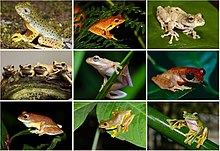Rhacophoridae
| Rhacophoridae | |
|---|---|

| |
| Rhacophoridae diversity | |
| Scientific classification | |
| Domain: | Eukaryota |
| Kingdom: | Animalia |
| Phylum: | Chordata |
| Class: | Amphibia |
| Order: | Anura |
| Suborder: | Neobatrachia |
| Family: | Rhacophoridae Hoffman, 1932 |
| Subfamilies | |
Rhacophoridae is a family of frog species. They live in tropical regions of Asia and Africa. They are commonly known as shrub frogs. Sometimes they are called "'moss frogs" or "bush frogs." Some Rhacophoridae are called "tree frogs." Among the most spectacular members of this family are numerous "flying frogs."
Most of the species are arboreal. This may include reproducing in trees. Mating frogs, while in amplexus, hold onto a branch, and beat their legs to form a foam. The eggs are laid in the foam. They are then covered with seminal fluid. Then the foam hardens into a protective casing. In some species, this is done in a large group. The foam is laid above a water source, so the tadpoles fall into the water once they hatch.[1]
The species in this family vary in size, from 1.5 centimetres (0.59 in) to 12 centimetres (4.7 in).[1] Like other arboreal frogs, they have toe discs. This family has the Old World flying frogs, including Wallace's flying frogs (Rhacophorus nigropalmatus). These frogs have extensive webbing between their hands and feet. This lets them glide through the air.[2]
Genera
[change | change source]- Subfamily Buergeriinae Channing, 1989
- Buergeria Tschudi, 1838
- Subfamily Rhacophorinae Hoffman, 1932 (1858)
- Beddomixalus Abraham, Pyron, Ansil, Zachariah, and Zachariah, 2013
- Chirixalus Boulenger, 1893
- Chiromantis Peters, 1854
- Feihyla Frost, Grant, Faivovich, Bain, Haas, Haddad, de Sá, Channing, Wilkinson, Donnellan, Raxworthy, Campbell, Blotto, Moler, Drewes, Nussbaum, Lynch, Green, and Wheeler, 2006
- Ghatixalus Biju, Roelants, and Bossuyt, 2008
- Gracixalus Delorme, Dubois, Grosjean, and Ohler, 2005
- Kurixalus Ye, Fei, and Dubois, 1999
- Leptomantis Peters, 1867
- Liuixalus
- Mercurana Abraham et al., 2013[3]
- Nasutixalus Jiang, Yan, Wang, and Che, 2016
- Nyctixalus Boulenger, 1882
- Orixalus
- Philautus Gistel, 1848
- Polypedates Tschudi, 1838
- Pseudophilautus Laurent, 1943
- Raorchestes Biju, Shouche, Dubois, Dutta, and Bossuyt, 2010
- Rhacophorus Kuhl and Van Hasselt, 1822
- Rohanixalus Biju, Garg, Gokulakrishnan, Chandrakasan, Thammachoti, Ren, Gopika, Bisht, Hamidy, and Shouche, 2020
- Romerus Dubois, Ohler, and Pyron, 2021
- Taruga Meegaskumbura, Meegaskumbura, Bowatte, Manamendra-Arachchi, Pethiyagoda, Hanken, and Schneider, 2010
- Theloderma Tschudi, 1838
- Vampyrius Dubois, Ohler, and Pyron, 2021
- Zhangixalus Li, Jiang, Ren, and Jiang, 2019
Phylogeny
[change | change source]This group of frogs is related to other frogs:[4]
| Rhacophoridae |
| ||||||||||||||||||||||||||||||||||||||||||||||||||||||
References
[change | change source]- ↑ 1.0 1.1 Zweifel, Richard G. (1998). Cogger, H.G. & Zweifel, R.G. (ed.). Encyclopedia of Reptiles and Amphibians. San Diego: Academic Press. pp. 99–100. ISBN 0-12-178560-2.
{{cite book}}: CS1 maint: multiple names: editors list (link) - ↑ Sunny Shah and Rachna Tiwari (2001-11-29). "Rhacophorus nigropalmatus, Wallace's Flying Frog". AmphibiaWeb. Retrieved 2007-06-22.
Edited by Tate Tunstall (2003-04-12)
- ↑ Robin Kurian Abraham; R. Alexander Pyron; Ansil B. R.; Arun Zachariah; Anil Zachariah (2013). "Two novel genera and one new species of treefrog (Anura: Rhacophoridae) highlight cryptic diversity in the Western Ghats of India". Zootaxa. 3640 (2): 177–189. doi:10.11646/zootaxa.3640.2.3. PMID 26000411.
- ↑ Yu Guohua, Rao Dingqi, Zhang Mingwang, Yang Junxing. Re-examination of the phylogeny of Rhacophoridae (Anura) based on mitochondrial and nuclear DNA. Molecular Phylogenetics and Evolution 50 (2009) 571–579. doi:10.1016/j.ympev.2008.11.023
- Cogger, H.G.; R.G. Zweifel and D. Kirschner (2004). Encyclopedia of Reptiles & Amphibians Second Edition. Fog City Press. ISBN 1-877019-69-0.
![]() Media related to Rhacophoridae at Wikimedia Commons
Media related to Rhacophoridae at Wikimedia Commons
